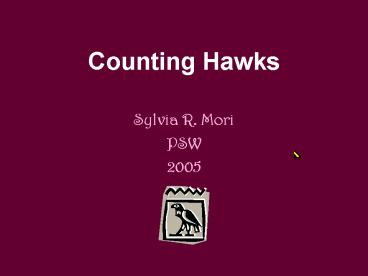Counting Hawks - PowerPoint PPT Presentation
1 / 16
Title:
Counting Hawks
Description:
Immature Northern goshawk (Accipiter gentilis ) Northern goshawk. Cooper's hawk. Relative Abundance. Sharp-shinned hawk. Number of sightings ... – PowerPoint PPT presentation
Number of Views:45
Avg rating:3.0/5.0
Title: Counting Hawks
1
Counting Hawks
- Sylvia R. Mori
- PSW
- 2005
2
(Accipiter striatus)
(Accipiter cooperii)
A small, jay-size hawk (avg. 10-14" long), with
dark gray back, a rusty-barred breast, a slender
square-tipped tail.
A medium crow-size hawk (avg.14-20" long) with a
dark gray back, a rusty-barred breast, dark
cap,and a long, rounded tail.
3
Immature Sharp-shinned Hawk
Immature Cooper's
(Accipiter striatus)
(Accipiter cooperii)
4
Immature Northern goshawk (Accipiter gentilis )
5
Relative Abundance
Number of sightings
Coopers hawk
Sharp-shinned hawk
Northern goshawk
6
The Golden Gate Raptor Observatory (GGRO) is
three staff members and more than 250 community
volunteers, all dedicated to studying the autumn
hawk migration
The GGRO is a program of the Golden Gate
National Parks Conservancy in cooperation with
the National Park Service
http//www.ggro.org/
7
Every autumn, thousands of migrating birds of
prey appear over the Golden Gate near San
Francisco, California
8
Questions
- How is the Hawk population doing? Are they
increasing, decreasing or the same?
Statistical technique Trend analysis
- What are the proportions of misidentification
- for Coppers hawks and Sharp-shinned hawks
- by age class and sex?
Statistical technique Estimation of
misclassification probabilities
9
Counting Hawks 18 years of count data (1986-2003)
- Measured variables for trend analysis
- Number of birds counted by a group of trained
observers (2-20), - Year of the observation (Y),
- Age class (adult, juvenal or unknown) (A) ,
- Time of the year in Julian days (J),
- Time of the observation in hours on day of the
observation (T), - Duration of the observation in minutes (D),
- Number of observers class (1 if lt7 2 if 7)
(O), - Visibility class (1if lt10 miles 2 if 10 miles)
(V).
Number of birds counted is the response of
interest
10
Trend analysis
- Statistical model
The parameters in the functions are estimated via
Maximum Likelihood Estimation (MLE)
Example
estimate
11
(No Transcript)
12
Julian Day of maximum abundance calculation
Fix all the explanatory variables except for the
Julian day J, therefore the above equality is
equivalent to
Using the derivative of zo with respect to J, the
maximum is given by
The Julian day 298 corresponds to October 25
13
Julian Day of Maximum abundance and variance
The delta method
- The delta method expands a (non-linear) function
of a random variable about its mean with a
one-step Taylor approximation, and then takes the
variance. - f(x) f(mu) (x-mu)f'(mu)
- so that
- Var(f(x)) Var(x)f'mu)2
- where f() is differentiable and f'() df/dx.
- Expanded to vector-valued functions of random
vectors, - Var(f(X)) f'(mu) Var(X) f'(mu)T
- and that in fact is the basis for deriving the
asymptotic variance of maximum likelihood
estimators. X is a 1 x p column vector Var(X)
is its p x p variancecovariance matrix f() is a
vector function returning a 1 x n column vector
and f'() is its n x p matrix of first (partial)
derivatives. T is the transpose operator.
Var(f(X)) is the resulting n x n
variancecovariance matrix of f(X).
14
Vector X(a,b)
Using the Delta Method, the estimated variance of
the Julian day of maximum abundance is
approximated by
15
A statistical computing procedure estimates the
parameters of the statistical model via MLE .
This procedure can also estimate the variance of
the estimated Julian day of maximum abundance and
its 95 confidence interval
16
(No Transcript)































